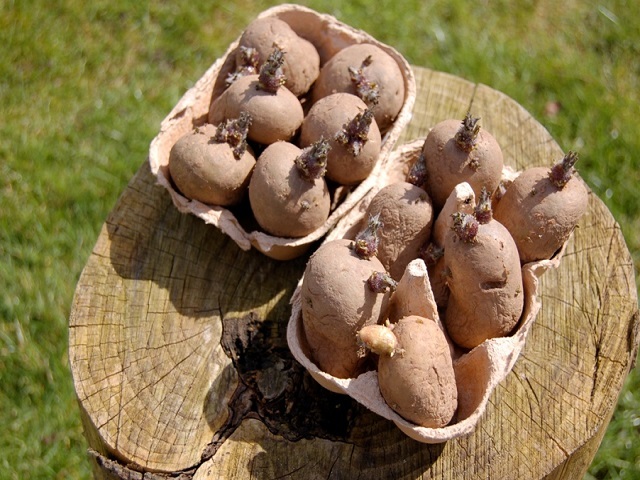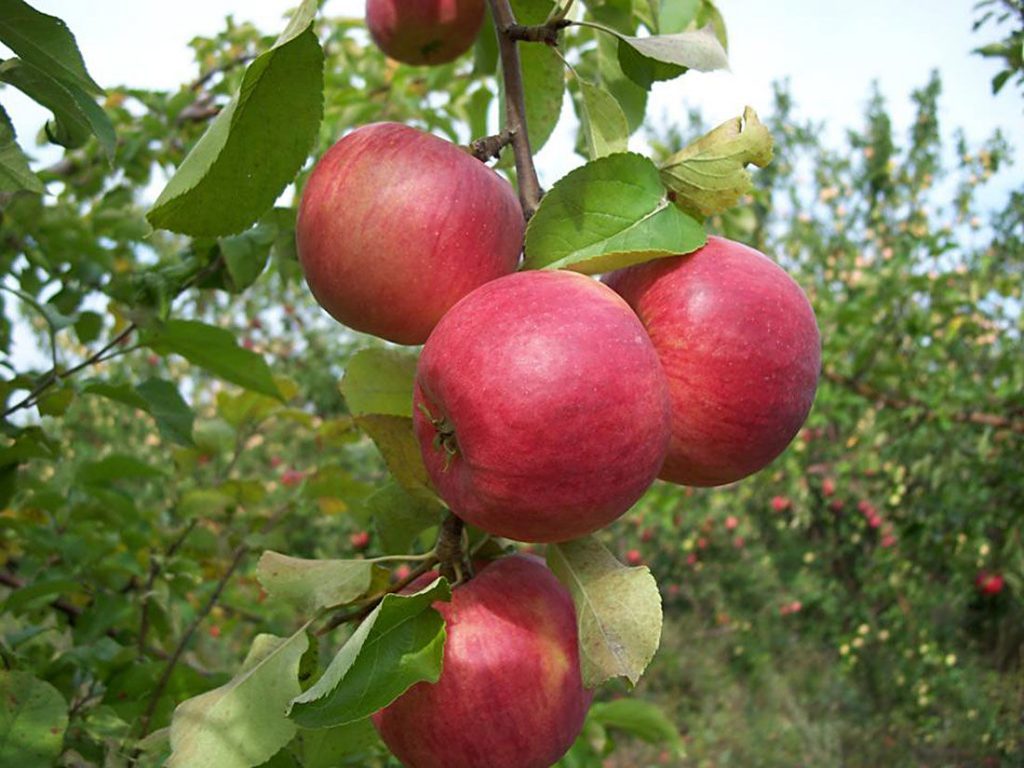Potatoes are one of the crops found in almost every garden plot. Variety Lapot got its name due to the shape and size of tubers. This is one of the old varieties that successfully withstands competition with the mass of new products that have appeared on the market.
Content:
- Growing history
-
Description
- Characteristic
-
Growing
- Soil selection
- The timing
- Tuber preparation
-
Landing pattern
- Video: about planting potatoes down sprouts
-
Care
- Blight prevention
- Reviews about the potato variety Lapot
Growing history
Potato Lapot appeared in the last century in Siberia, its other name is Siberian lapot. There is no mention of authorship, it is considered a variety of folk selection.
Some sources indicate a kinship with Ermak potatoes.

Potato fruits Lapot - large elongated tubers
Description
Bushes of potato Lapot low, upright, slightly above 0.5 m, densely leafy. The flowers are white, collected in inflorescences. The shape of root crops is flat-oval, elongated. Eyes are shallow. The average fruit mass is 150–160 g, but potatoes weighing up to 500–700 g are also found.
The tubers are covered with a pale pink peel. Creamy flesh, excellent taste, starch content up to 12%. When cooking, potatoes are boiled. Tubers are well transported and stored.
The average weight of the fruit of the potato Lapot - 150 g
Characteristic
Bast shoes are potato varieties with a medium early maturity. From the moment of planting to harvesting, 65–80 days pass. When planting varieties on light fertilized lands receive up to 500 kg of tubers from 100 m2. At the same time, the variety is not very demanding on soil composition and maintenance. With obvious advantages, the variety has a significant drawback: The bast shoe is sensitive to late blight.
Growing
Potato is an unpretentious culture and grows on almost any soil, tolerating temperature fluctuations. But under certain conditions, you can significantly increase the yield.
Soil selection
A high yield of potatoes is provided by fertile and light soils: sandy or light loam. The culture grows poorly in lowland areas with a high occurrence of groundwater. Prefers slightly acidic soils.
If there is a lot of horsetail on the plot among the weeds, it can be assumed that the soil is acidic. For deoxidation, add 2-3 tbsp. To each well. l ash, which is also a source of potassium.
Organic fertilizers decompose slowly, so you need to add them to the loams in advance, in the fall. In the spring, only rotted manure is brought in. Light soils fertilize in the spring. It is advisable to add 2-3 kg of superphosphate per 100 kg of manure. Estimated rate of manure 20-30 kg / m2. By applying fertilizer to each well, they reduce organic consumption by almost 3 times.

Fertilizing directly into the hole reduces organic consumption
Most preferred for potatoes are those areas where legumes or siderates (white mustard, barley) were previously grown.. When reusing plots for potatoes, there is a danger of defeating the tubers with scab, rhizoctoniosis, late blight, or the Colorado potato beetle. Pathogens and beetle larvae safely overwinter. The best prevention of infection of tubers is the use of crop rotation and change of seed material.
The timing
For the formation and intensive growth of roots, it is necessary that the temperature of the soil at a depth of 7–10 cm be higher than 7–8aboutWITH. Planting too early does not lead to an early harvest - the soil should warm up.
There is a sign that potatoes are planted when leaves on a birch open.
Tuber preparation
Healthy, clean seed tubers are selected for preplant treatment 1–1.5 months before planting. Usually this time falls in the middle or end of March. Potatoes are sprouted at a daily temperature of 10-15aboutC and not lower than 4–6aboutWith the night. The length of the sprouts should not be more than 2 cm, so as not to break off when planting.
Before planting, to increase stress resistance, it is recommended to etch the tubers with solutions of Fitosporin, Maxim or Prestige. They have fungicidal, insecticidal and adaptogenic effects.

Potato tuber sprouts should not be long
Landing pattern
In lowlands or plots with heavy clay soil, it is preferable to use a ridge method of planting. Water does not stagnate, it evaporates better, and the soil layer warms up well. At a distance of 60–70 cm from each other, ridges 25–30 cm high are cut. Wells are dug at a distance of 30–35 cm. The crests warm up during the day and give off heat at night, due to this, potatoes can be planted earlier.

The comb method of planting potatoes is used in areas with heavy soil
If the soil is light sandy in the area, it is better to use a smooth method of planting potatoes. Mark the rows with a thick cord, and dig holes at a distance of 30–35 cm. Or a furrow is simply cut, on the bottom of which tubers are laid out. With this method, moisture evaporates less. And with the threat of a dry summer, the tubers are closed up to a depth of 14–16 cm in the sandy soil. The depth of planting potatoes in loam is only 4-6 cm.

Planting potatoes in furrows rather than holes speeds up the process
The beds are oriented from north to south to provide plants with better illumination. To form a more spreading bush, it is recommended to plant potatoes down with sprouts. When germinating, the shoot has to go around the mother tuber, and the stems are at a greater distance from each other.
Video: about planting potatoes down sprouts
Care
Potatoes have a long pre-emergence period, and when planted in fertilized soil there is a threat to grow a rich crop of weeds. Therefore, no later than 5-6 days after planting, they begin to loosen the soil. The roots of weeds at this time are still tender, they die quickly. The next cultivation is recommended to be carried out in a week, thus the remaining weeds are destroyed. After the appearance of the first potato seedlings, they proceed to the processing of aisles.
If the summer is not very dry, you can not water the potatoes before flowering. But during the flowering period, plants are abundantly watered with warm water, avoiding its contact with the leaves. Depending on the state of the soil and the abundance of precipitation, only 2-3 irrigation should be carried out during the whole period of potato vegetation.

During flowering, potatoes are abundantly watered
They are well reflected on top dressing plants in the form of nettle infusion or other weeds. To reduce the evaporation of moisture and to reduce the frequency of irrigation, mulching of potato bushes with grass or mowed siderates is used. When overheated, they provide plants with organic matter and moisture.
2-3 weeks before harvesting, the potatoes cease to be watered, and 7-10 days before harvesting, the tops of the bushes are cut so that the soil dries faster and the tubers ripen.
Blight prevention
- If you have to plant potatoes in the same place for the second or third time, before planting the tubers, the area is shed with a 3% solution of copper-containing preparations: Bordeaux liquid or copper sulfate. At the same time, tubers are not treated with Fitosporin, since copper preparations inhibit its action, and other means are used - Maxim or Prestige.
- After the appearance of the tops, the bushes are treated either with copper preparations, or with a well-proven contact action agent - Thanos. It is stored on the leaves and stems of potatoes, preventing phytophthora spores from spreading throughout the plant. Another effective contact drug is Shirlan.
- Sometimes gardeners follow the path of stimulating tuberization to get a crop before late blight develops.. For this purpose, tubers are treated with Immunocytophyte.
- Alternative methods of controlling late blight (for example, spraying with lactic acid solutions) are used only as a prophylaxis. At the first signs of the disease, fungicide plantings need to be treated, and it is best to alternate the drugs so that there is no getting used to it.

Preventive measures will protect potatoes from late blight
Reviews about the potato variety Lapot
I want to mention such a variety of potatoes as Lapot, not just big ones - giant tubers! When planted for the first time, they did not believe their eyes when harvesting, several tubers - a full bucket! And this is on soil that has not been fertilized, what will happen if the land is removed before planting potatoes?
Tasty, but lately it has become shallow, but before it really was like huge flat bast shoes.
Potato Lapot was liked by vegetable growers for the impressive size of the tubers, as well as the unpretentiousness of the plant. There are connoisseurs of tradition, cultivating it for taste and productivity. I am glad that next to the newfangled overseas potato varieties Lapot is not lost.
© 2019, homeli.ru. Copying is allowed only with a link back to the source


